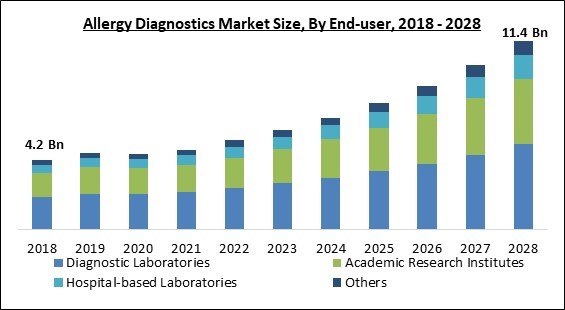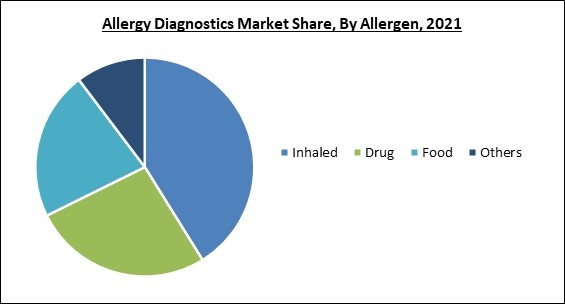The Global Allergy Diagnostics Market size is expected to reach $11.4 billion by 2028, rising at a market growth of 13.3% CAGR during the forecast period.
Techniques for diagnosing allergies include skin prick tests, patch tests, intradermal tests, and blood tests. As pollution levels rise, the market for allergy diagnostics is anticipated to expand. The main risk factors for chronic respiratory illnesses include occupational exposure, exposure to allergens, and exposure to both indoor and outdoor air pollution.
Due to their greater exposure to environmental pollutants, urban individuals are more susceptible than rural ones to suffering allergy disorders. The market for allergy diagnostics is expected to grow due to the increase in food allergies. The allergy cases are more common in urban areas instead of rural areas. The degree of cleanliness and potential for infectious diseases is one of the most noticeable differences between these places.
Early exposure to viral, bacterial, and parasite infections as well as exposure to a number of common human body micro-organisms are predicted to have an impact on immune system development. Climate change, air pollution, as well as the complexity of materials and cosmetic products have all contributed to a rise in the prevalence of sensitive skin and its susceptibility to irritation. These elements are anticipated to fuel the market for allergy diagnostics in the near future.
The market research report covers the analysis of key stake holders of the market. Key companies profiled in the report include Danaher Corporation, Hitachi chemical Diagnostic Inc., Hycor Biomedical Inc., Lincoln Diagnostics Inc., Omega Diagnostic Llc, Siemens Healthcare Diagnostics, Inc., Thermo Fisher Scientific Inc., Neogen Corporation, Eurofins Scientific Group, and ACON Laboratories, Inc.
Techniques for diagnosing allergies include skin prick tests, patch tests, intradermal tests, and blood tests. As pollution levels rise, the market for allergy diagnostics is anticipated to expand. The main risk factors for chronic respiratory illnesses include occupational exposure, exposure to allergens, and exposure to both indoor and outdoor air pollution.
Due to their greater exposure to environmental pollutants, urban individuals are more susceptible than rural ones to suffering allergy disorders. The market for allergy diagnostics is expected to grow due to the increase in food allergies. The allergy cases are more common in urban areas instead of rural areas. The degree of cleanliness and potential for infectious diseases is one of the most noticeable differences between these places.
Early exposure to viral, bacterial, and parasite infections as well as exposure to a number of common human body micro-organisms are predicted to have an impact on immune system development. Climate change, air pollution, as well as the complexity of materials and cosmetic products have all contributed to a rise in the prevalence of sensitive skin and its susceptibility to irritation. These elements are anticipated to fuel the market for allergy diagnostics in the near future.
COVID-19 Impact Analysis
Due to the COVID-19 outbreak, there was a little reduction in the market for allergy diagnostic. Given that suffering patients are well-instructed about avoiding probable environmental triggers and treating acute occurrences, also based on written action plans, diagnostic tests were postponed in the majority of allergic disorders. However, after the pandemic was under control, the diagnostic processes were restarted. To determine the impact of COVID-19 on allergy diagnostic testing services, several researches have been done.Market Growth Factors
Increasing levels of environmental pollution
The main risk factors for developing chronic respiratory disorders include occupational exposure, allergen exposure, and exposure to indoor and outdoor air pollution. Due to the greater exposure to environmental toxins in cities, the prevalence of allergy illnesses is higher among urban residents than rural residents (as a result of vehicular pollution and industrial activities). Although this is a worldwide phenomenon, its impacts are more severe in the metropolitan regions of low-income nations, where more than 80% of people live in locations where air quality levels exceed WHO safety guidelines.Using mobile health to diagnose allergies
There are currently just a few mHealth tools for diagnosing allergic rhinitis (AR) that have been published in peer-reviewed publications, which limits the use of mHealth for the diagnosis of rhinitis. A new breed of point-of-care devices is produced by recent advancements in wireless communication, integrated biosensors, and power harvesting techniques. However, AR is a very widespread illness all over the world. Peak nasal inspiratory flow meters and intranasal biosensors are only two examples of diagnostic tools that can be connected to smartphones.Market Restraining Factors
Instruments for diagnosing allergies come at a premium price
Market competitors regularly update a number of allergy diagnostic tools, including luminometers, scanners, blot analyzers, ELISA analyzers, and immunoassay analyzers. These instruments cost more because they come with cutting-edge features and functions (the cost of each instrument varies on the basis of its flexibility, accuracy, and TAT). Due to their substantial capital expenditures and ability to purchase high-volume systems, large hospitals and diagnostic laboratories hold a higher portion of the market.End User Outlook
Based on end-user, the allergy diagnostics market is classified into diagnostics laboratories, hospital-based laboratories, academic research institutes and others. The hospital-based laboratories segment registered a significant revenue share in the allergy diagnostics market in 2021. There are a large number of hospitals operated by private as well as public authorities. The government is largely supporting this segment and thus is increasing the healthcare spending in hospitals-based laboratories. These elements would further support the allergy diagnostics market growth in the near future years.Allergen Outlook
By allergen, the allergy diagnostics market is divided into inhaled allergens, food allergens, drug allergens, and other allergens. The inhaled segment held the largest revenue share in the allergy diagnostics market in 2021. Rising pollen and environmental pollution levels, along with other factors such as dust, mould, and fungus, may be responsible for the allergy diagnostics market rise in the inhaled allergens segment. These elements could all increase consumer demand for inhaled allergens and thus would hasten market growth over the forecast period.Test Type Outlook
Based on test type, the allergy diagnostics market is segmented into in vitro and in vivo. The in vitro segment acquired a substantial revenue share in the allergy diagnostics market in 2021. The in vitro test is used to determine the presence of immunoglobulin E specific to allergens (IgE). An in-vitro method for identifying allergen-specific antibodies of a novel immunoglobulin class, tentatively referred to as IgND, is the radio allergosorbent test. The advantages of in vitro testing include its compatibility with any skin condition, lack of systemic reaction risk, lack of steroid or anti-histaminic effects, and absence of compatibility issues.Product & Services Outlook
On the basis of product & services, the allergy diagnostics market is fragmented into consumables, instruments, and services. In 2021, the consumable segment witnessed the highest revenue share in the allergy diagnostics market. The increased number of allergies that require rapid detection is one of the factors pushing market expansion. Major market players across the globe are also collaborating strategically to give consumers improved allergy diagnoses. These factors and strategic alliances by significant companies may contribute to the segments throughout the projection period.Regional Outlook
Region wise, the allergy diagnostics market is analyzed across the North America, Europe, Asia Pacific and LAMEA. In 2021, the North America region led the allergy diagnostics market with the maximum revenue share. The growth of the regional market is primarily driven by the rising number of allergy sufferers, improved healthcare infrastructure, as well as cutting-edge diagnostic technologies. As the number of fatalities linked to pharmaceutical allergies rises, so will the demand for rapid and reliable allergy diagnosis.The market research report covers the analysis of key stake holders of the market. Key companies profiled in the report include Danaher Corporation, Hitachi chemical Diagnostic Inc., Hycor Biomedical Inc., Lincoln Diagnostics Inc., Omega Diagnostic Llc, Siemens Healthcare Diagnostics, Inc., Thermo Fisher Scientific Inc., Neogen Corporation, Eurofins Scientific Group, and ACON Laboratories, Inc.
Scope of the Study
Market Segments Covered in the Report:
By End-user
- Diagnostic Laboratories
- Academic Research Institutes
- Hospital-based Laboratories
- Others
By Allergen
- Inhaled
- Drug
- Food
- Others
By Test Type
- In Vivo
- In Vitro
By Product & Services
- Consumables
- Instruments
- Services
By Geography
- North America
- US
- Canada
- Mexico
- Rest of North America
- Europe
- Germany
- UK
- France
- Russia
- Spain
- Italy
- Rest of Europe
- Asia Pacific
- China
- Japan
- India
- South Korea
- Singapore
- Malaysia
- Rest of Asia Pacific
- LAMEA
- Brazil
- Argentina
- UAE
- Saudi Arabia
- South Africa
- Nigeria
- Rest of LAMEA
Key Market Players
List of Companies Profiled in the Report:
- Danaher Corporation
- Hitachi chemical Diagnostic Inc.
- Hycor Biomedical Inc.
- Lincoln Diagnostics Inc.
- Omega Diagnostic Llc
- Siemens Healthcare Diagnostics, Inc.
- Thermo Fisher Scientific Inc.
- Neogen Corporation
- Eurofins Scientific Group
- ACON Laboratories, Inc.
Unique Offerings from the Publisher
- Exhaustive coverage
- The highest number of Market tables and figures
- Subscription-based model available
- Guaranteed best price
- Assured post sales research support with 10% customization free
Table of Contents
Chapter 1. Market Scope & Methodology
Chapter 2. Market Overview
Chapter 3. Global Allergy Diagnostics Market by End-user
Chapter 4. Global Allergy Diagnostics Market by Allergen
Chapter 5. Global Allergy Diagnostics Market by Test Type
Chapter 6. Global Allergy Diagnostics Market by Product & Services
Chapter 7. Global Allergy Diagnostics Market by Region
Chapter 8. Company Profiles
Companies Mentioned
- Danaher Corporation
- Hitachi chemical Diagnostic Inc.
- Hycor Biomedical Inc.
- Lincoln Diagnostics Inc.
- Omega Diagnostic Llc
- Siemens Healthcare Diagnostics, Inc.
- Thermo Fisher Scientific Inc.
- Neogen Corporation
- Eurofins Scientific Group
- ACON Laboratories, Inc.
Methodology

LOADING...










